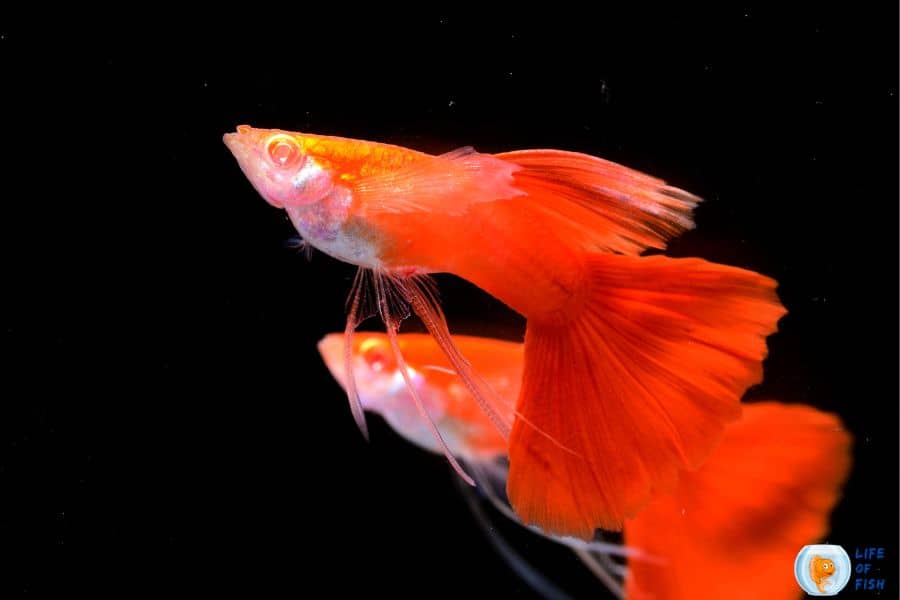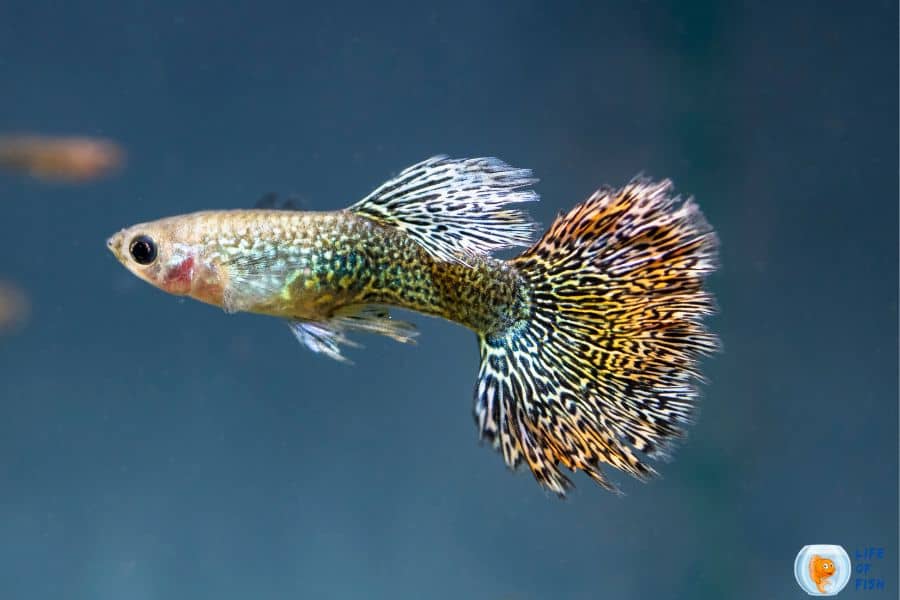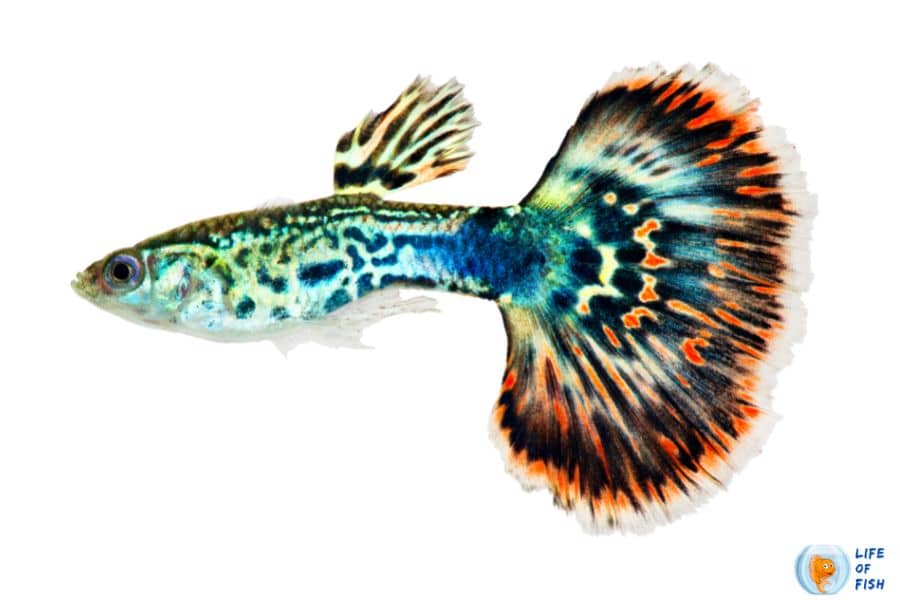Can Male Guppies Live Together in The Same Tank? Yes of course. But you have to follow a few steps to set up a beautiful and peaceful male-only guppy tank. In this article, I am going to discuss this in detail.

There are many ways and reasons to set up a “male only” guppy tank. If you fear that a guppy tank will be filled up with hundreds of guppy fry when male and female guppies are kept together, then this is a great way to control the population of guppies in the tank.
A male-only guppy tank is not different than any other tank except there are certain rules that you must follow so that all the males in the tank are happy and live longer.
In the case of a male and female tank, it’s a high probability that females will get pregnant frequently giving birth to hundreds of fry and taking care of all these can be a big problem for some tank owners.
Setting up a male and female guppy tank is not an issue unless you are into the guppy breeding business. But if you are just a hobbyist then setting up a “male only” guppy tank is advisable and also a great way to control the guppy population in the tank.
What is the ideal number of male guppies in a tank?
Jump To
- 1 What is the ideal number of male guppies in a tank?
- 2 Do male guppies fight frequently in the tank?
- 3 Are fights in a guppy tank deadly?
- 4 Can Male Guppies Live Together in The Same Tank?
- 5 Follow these simple rules to avoid fights in a fish tank
- 6 Precautions to take while buying guppies for a male only tank
- 7 Here are some rules to follow
- 8 Everything looks good, but guppies are still fighting
- 9 Conclusion
- 10 Short bio of the guest post author
When it comes to setting up a male-only guppy tank the first challenge that you’ll face is aggression amongst fish and how many fish are enough in the same tank.
Fish love to have their own territory in the tank and when their privacy and territory get threatened because of other male fish, they tend to get aggressive.
They show their aggression by biting, chasing other fish, nipping fins, etc. If not controlled, this can lead to deadly fights also and weaker fish in these fights can go under stress attracting diseases in the long run.
A general rule that is followed in the aquarium community is 1 guppy fish for 2 to 2.5 gallons of water volume.
If you follow this rule then most of the time each individual guppy will have his own space in the tank and fights will be minimized.
The number of guppies must be chosen in such a way that any particular guppy fish doesn’t get attacked in the tank.
With there being too many guppies in the tank it’s possible that all fish form a team and attack an individual weaker fish. When this happens he will quickly go under stress and fall sick. If he attracts a contagious disease then this can be deadly for the entire tank.
With too less fish, since there are fewer “distractions” around it’s possible that a single guppy gets attacked frequently resulting in sick fish. So maintaining a balanced number is really a challenge in a “male only” guppy tank.

Do male guppies fight frequently in the tank?
Guppies are peaceful yet swift in the tank. If you observe their behavior in the tank you’ll notice that guppies are tiny fish with swift movements.
However, they are peaceful fish and will not attack if their privacy and territory are not encroached on by other fish.
Normally guppies will attack other male guppies in the form of chasing, frequent biting, nipping fins, etc. However, this is not a frequent behavior. As a tank owner, it’s your duty to observe guppies every day for abnormal activity in the tank.
Most of the time abnormal activity or erratic behavior in fish is a sign of stress and this is a serious issue.
The primary reason for stress in fish is the poor quality of water. But if you are maintaining your tank regularly then you must find out other reasons for stress and try to eliminate them immediately.
In the case of a “male only” guppy tank, the reason for fights could be an absence of females. Dominant male guppies can try to establish dominance in the tank by attacking weaker and smaller fish and this must be observed every day.
Are fights in a guppy tank deadly?
Guppies are primarily peaceful fish but when they swim in the tank they seem swift in movement.
These are tiny fish and grow about an inch in length. When male guppies are kept together in the same tank, the dominant fish will try to bully weaker ones for their territory.
This bullying can be in the form of chasing, nipping fins, biting etc. If a guppy bites another one or nips his fins then it is necessary to observe this behavior because nipping fins can cause tearing of fins.
Fish can catch up a disease called as “fin rot” if fins are not cured or the injured fish is not treated.
It is best to create conditions in the tank that don’t encourage fights amongst fish. But since these are live animals with survival instincts you can’t’ avoid fights 100% of the time.
If you find frequent fights in the guppy tank then it is better to make the necessary modifications to the tank such as
- Remove the dominant fish
- Remove the weaker fish
- Create hiding spaces for each fish
- Maintain a balanced number of guppies
- Always pay attention to the quality of water using a water testing kit.
Can Male Guppies Live Together in The Same Tank?
Yes, they can. But there are many factors that encourage and trigger fights in a male-only guppy tank.
Territorial encroachment
Fish do love to have their own territory in the tank. But when they get encroached in the tank, fish tend to get aggressive sometimes. To avoid this, have a bigger tank with a balanced number of fish in it.
Absence of females
In a male-only tank, the lack of females can have a big impact on the aggressive behavior of the fish. Bigger and stronger fish will try to maintain dominance over weaker ones by attacking and showing their power.
Fish with long silky fins
Many people ignore this but beautiful looking fish with longer silky fins can actually annoy other fish in the tank.
These beautiful fish with longer fins can be a reason to trigger aggression in the fish tank and lead to fights. Some fancy guppy species tend to have such long fins. They must be introduced in a male guppy tank with precautions.
Water quality
Poor water quality encourages stress in fish and stress attracts disease in weaker fish quickly. Always try to maintain water quality good by limiting levels of dissolved toxic gases.

Follow these simple rules to avoid fights in a fish tank
There are many ways to go about avoiding fights in a male-only guppy tank. Some of these rules will give you immediate effects, but some will require some duration to see results.
Size of the tank
With a bigger tank, each individual guppy will have his own territory. Then he’ll be happier than in a smaller tank with congestion. Too many guppies in the same tank with a smaller volume will obviously annoy every fish.
Maintain a suitable number of guppies
While setting up a “male only” guppy tank, the number of guppies will have a major role. As a general rule, 1 guppy for 2-2.5 gallons of water volume is sufficient to start with.
Once you have this setup, observe their behavior every day and check for any abnormal or erratic swimming patterns or behavior.
The secret formula for a successful “male only” guppy tank is correct water volume with a correct number of guppies so that all fish are happy and allow freedom to each other.
Maintain water quality
This should be at the top of the list and is not an option but an absolute necessity. Aquarium keeping is all about learning to keep the water clean and healthy for all fish, not just guppies.
If water is toxic, fish will go under stress and this will show in their behavior. Normally a fish under stress will attract some kind of disease making him weak and open to attacks from other bigger and dominant fish.
Try to create hiding spaces
There are many creative ways to create hiding spaces in the tank. You can use decorating rocks, decorating accessories, live plants etc. to do this.
In case a particular fish is being bullied continuously he can use these tiny spaces for protection.
Always buy healthy guppies for your tank
Many people ignore the important fact that when you buy new fish, it’s necessary that it’s healthy.
Many people just assume that the fish you are buying is free of diseases, but this can be a big mistake.
If budget allows you, always have a quarantine tank set up just like your main tank. Then introduce the newly bought fish first in the quarantine tank for at least 30 days.
Fish bought from pet stores are under great stress. Also, you don’t; have the slightest idea of what kind of precautions the breeding farm takes from where these fish come.
If you introduce sick guppies in the tank it won’t take much time to transfer his disease to the entire tank if this disease is a contagious one.
Precautions to take while buying guppies for a male only tank
As mentioned earlier it is necessary that male guppies you buy are healthy and are not carrying any disease in the first place.
Identifying a sick fish from a healthy one just by looking at him from outside the tank is not easy and requires experience.
However, there are certain behavioral characteristics that you can check before you buy them. A sick fish will most definitely transfer disease to another fish and eventually, the entire tank gets affected.

Here are some rules to follow
Try to buy male guppies from a local breeding farm in your area because they have better control over the quality of fish.
Bigger pet stores normally outsource or buy from smaller breeding farms and have no clue of what’s going on when the guppies are being produced.
Go and personally visit a few breeding farms and ask questions or examine their efforts to maintain hygiene. This extra step will confirm that the fish being produced are disease free.
No matter how much you try to prevent you’ll get a sick fish because these are tiny and extremely sensitive to the surrounding environment such as constant movement, water temperature, water quality, food etc.
These tiny fish go through lots of movement before they land in your tank, so it’s possible that they are under stress and already carrying some disease or are just starting out with signs of disease.
In such cases always introduce the new guppy in a quarantine tank and examine him for 30 days before you put him in the main tank. This will ensure that the male guppy is free of disease and your main tank is safer.
While buying male guppy observes his behavior, swimming patterns, any erratic swimming movements as compared to other fish, his eating habits etc.
If the fish is under stress, he will show some sign of erratic behavior. It takes experience to identify stress in fish just by looking at him, but you can identify this by practice.
Keep a habit of observing your fish even when they are healthy because then only you’ll be able to identify the difference e between a sick and a healthy guppy
Everything looks good, but guppies are still fighting
You have done everything well, the water quality is intact and even the size of the tank and number of fish is accurate, but still, fights are frequent in your tank. What can you do about it?
- Observe daily for triggers of fights. Are these fights just chasing or actually fish are biting or nipping fins of other fish. Casual chasing is not fighting but sometimes fish are playing with each other.
- Observe fish behavior, their color, movements, to identify if they are under stress or not.
- Observe how much food they consume when you feed them daily. If fish are under stress you’ll notice a loss of appetite and fish will eat less.
- Are they constantly hiding behind decorations or plants?
- Observe if a particular fish is bullying others or a particular fish is being bullied all the time. In such case remove either the stronger or the weaker one from the tank. By removing just this one fish you’ll have a safer habitat for the rest of the fish.
By making smaller modifications you can control fights easily and have a healthy and happy tank for all the fish in the tank
Conclusion
Setting a male only guppy tank is definitely possible once you study and understand how guppies live and thrive in the wild environment.
All you have to do is mimic the exact habitat these fish love in your fish tank and try to maintain the habitat as closely as possible.
Prakash Ganguly is an intermediate aquarist who has been in the hobby for over 5 years and has been sharing his knowledge of fishkeeping ever since. For more information and advice from him, visit his blog GuppyPortal.com
Read Next : How Much Does A Rainbow Shark Cost, And How Big They Get?
